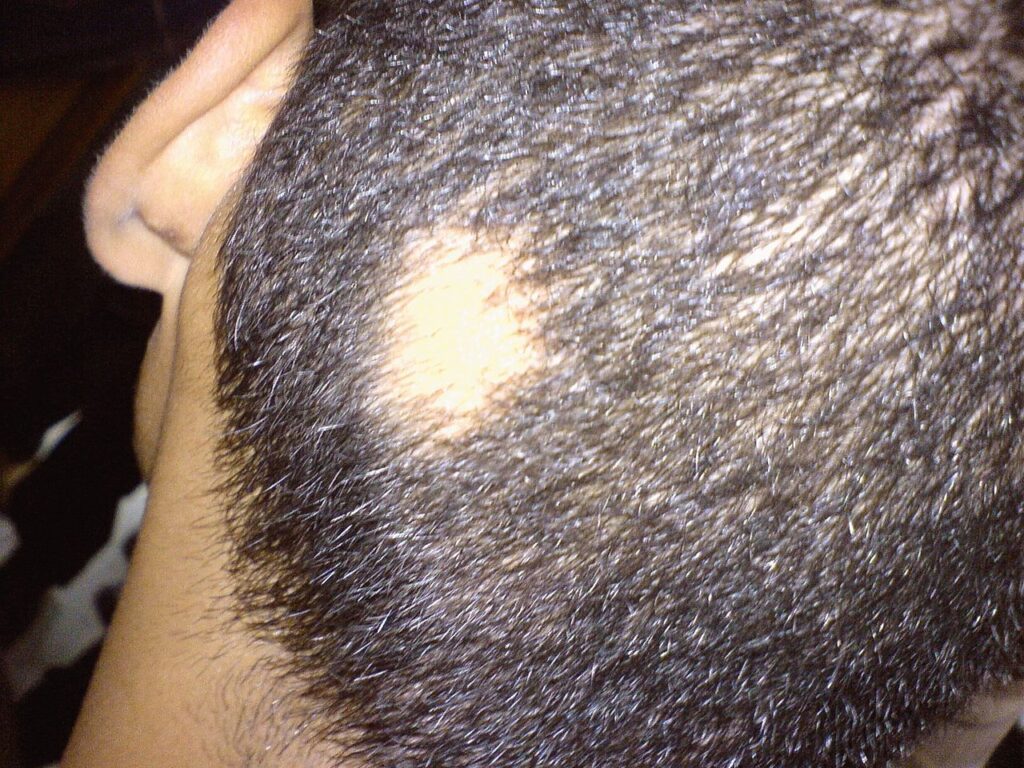Table of Contents
Understanding Alopecia Areata
Alopecia areata is an autoimmune disorder that causes hair loss on the scalp, face, and sometimes other areas of the body. This condition occurs when the immune system mistakenly attacks hair follicles, leading to hair loss. Alopecia areata can affect people of all ages, genders, and ethnicities.

Symptoms
The symptoms of alopecia areata can vary widely among individuals and can affect different parts of the body. Common symptoms include:
- Patchy Hair Loss: Round or oval bald patches on the scalp, beard, eyebrows, eyelashes, or other body areas.
- Smooth, Hairless Patches: Areas of hair loss that are smooth and not scarred.
- Nail Changes: Pitting, ridging, or brittleness of the nails.
- Regrowth of White or Fine Hair: Hair may regrow in the affected areas as fine, white hair before normal color and texture return.
When to See a Doctor
Early diagnosis and treatment of alopecia areata are crucial for managing the condition effectively and preventing extensive hair loss. You should see a doctor if you experience:
- Sudden or patchy hair loss on your scalp, face, or other body parts.
- Noticeable changes in your nails, such as pitting or ridging.
- Regrowth of white or fine hair in previously bald patches.
- Concerns about the emotional or psychological impact of hair loss.
Causes
The primary cause of alopecia areata is an autoimmune response where the body’s immune system attacks hair follicles. The exact trigger for this autoimmune response is unknown, but potential contributing factors include:
- Genetics: Family history of this or other autoimmune disorders.
- Immune System Malfunction: The immune system mistakenly targets hair follicles.
- Environmental Triggers: Factors such as stress, illness, or infections may trigger the onset of alopecia areata.
Risk Factors
Several factors may increase the risk of developing alopecia areata, including:
- Age: While it can occur at any age, it often develops in childhood or teenage years.
- Family History: Higher risk if a close relative has this or other autoimmune conditions.
- Other Autoimmune Disorders: Conditions such as thyroid disease, vitiligo, or rheumatoid arthritis increase the risk.
- Genetics: Certain genetic markers are associated with a higher risk.
Diagnostics
Diagnosing alopecia areata involves several steps:
- Medical History and Physical Exam: The doctor will review symptoms and perform a thorough physical examination of the affected areas.
- Scalp Biopsy: A small sample of scalp tissue may be taken to examine for inflammation and other signs of alopecia areata.
- Blood Tests: To check for underlying autoimmune conditions or other health issues.
Treatment Approaches
There is no cure for alopecia areata, but various treatment options can help manage symptoms and promote hair regrowth. Treatment approaches include:
- Medications:
- Corticosteroids: Topical, oral, or injectable corticosteroids to reduce inflammation and suppress the immune response.
- Topical Immunotherapy: Medications like diphencyprone (DPCP) to stimulate hair regrowth by provoking an allergic reaction.
- Minoxidil: Over-the-counter topical solution to promote hair growth.
- Anthralin: A topical medication used to treat psoriasis that can also promote hair regrowth in alopecia areata.
- Therapies:
- Light Therapy (Phototherapy): Using ultraviolet light to stimulate hair growth.
- Platelet-Rich Plasma (PRP) Therapy: Injections of platelet-rich plasma to encourage hair regrowth.
- Lifestyle and Home Remedies:
- Gentle Hair Care: Avoiding harsh hair treatments and using gentle hair care products.
- Stress Management: Techniques such as yoga, meditation, and deep breathing to manage stress, which can exacerbate symptoms.
- Wigs and Hairpieces: Using wigs, hats, or scarves to cover areas of hair loss and boost confidence.
Complications
Alopecia areata can lead to several complications if not properly managed, including:
- Emotional and Psychological Impact: Anxiety, depression, and low self-esteem due to changes in appearance.
- Nail Problems: Increased brittleness and pitting of the nails.
- Extensive Hair Loss: Progression to more severe forms of alopecia, such as alopecia totalis or alopecia universalis.
Recent Updates
Recent advancements in alopecia areata research include:
- JAK Inhibitors: Development of new medications targeting the Janus kinase (JAK) pathway to reduce immune system activity and promote hair regrowth.
- Genetic Research: Identifying genetic markers to better understand the genetic basis of alopecia areata and develop personalized treatments.
- Stem Cell Therapy: Exploring the potential of stem cell therapy to regenerate hair follicles and restore hair growth.
- Patient Support and Education: Increased efforts to provide support and education for individuals with alopecia areata to improve quality of life.
Conclusion
Managing alopecia areata effectively requires a comprehensive approach that includes medication, lifestyle changes, and regular consultations with healthcare providers. Early diagnosis and intervention are crucial in preventing extensive hair loss and improving quality of life. Staying informed about the latest research and treatment options can empower individuals to better manage their condition and maintain a good quality of life. If you experience persistent symptoms of alopecia areata, consult your doctor promptly for a thorough evaluation and appropriate management.
Additional Content
For comprehensive information on the various treatments you can explore our Autoimmune Disease Treatment page. If you are seeking expert medical advice, our Top Autoimmune Doctors section provides a list of highly recommended specialists. Additionally, for an overview of other autoimmune conditions, visit our Autoimmune Diseases page.